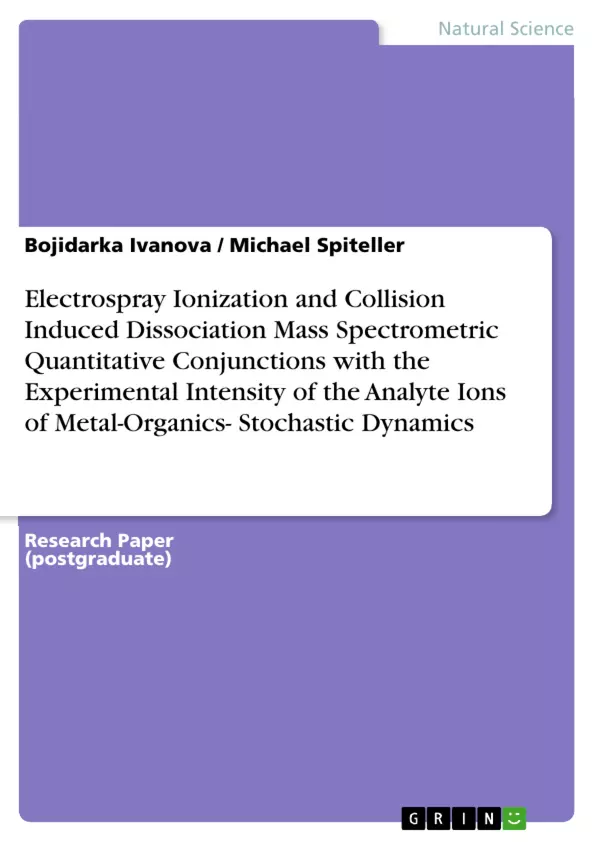Throughout the chapters in this book we argue that the temporal behaviour of the experimental mass spectrometric intensity of analyte ions obeys a certain and universal law based on a stochastic dynamic approach. The content of the book evidences convincingly through a selected series of examples to molecular systems of metal–organic complexes of transition metal ions with electronic configuration d10, for instance, AgI– and ZnII–ions, the validity of our model equation reported, more recently.
It needs to be underlined that, the comprehensive study that is provided, herein, is published, for first time in the literature. The book, therefore, represents monograph containing results from our research work, detailing correlatively experimental and theoretical mass spectrometric analyses of metal–organics using ultrahigh accuracy electrospray ionization and collision induced dissociation mass spectrometry. An enormous amount of effort is concentrated on a quantitative description of the relationships between experimental measurable parameter “intensity” and diffusion or kinetic parameters of analyte ions.
Inhaltsverzeichnis (Table of Contents)
- Preface
- Chapter 1: Validity of Our Model Equation. The Case of Ag-Complexes with Simple Inorganic Ligands
- Chapter 2: Quantification of Zn-Ion by Collision Induced Dissociation Mass Spectrometry. Stochastic Dynamic Diffusion Parameters of the Fragment Species. The Case of Oligopeptide Zn-Complex
- Chapter 3: The Effect of Collision Energy on Diffusion Parameters of Analyte Ions in Collision Induced Dissociation Mass Spectrometry. Quantitative Correlation Between Stochastic Dynamic Diffusion Parameters and Reaction Kinetics
Zielsetzung und Themenschwerpunkte (Objectives and Key Themes)
This book aims to demonstrate the validity of a universal law based on a stochastic dynamic approach for describing the temporal behavior of experimental mass spectrometric intensity of analyte ions. It focuses on metal-organic complexes of transition metal ions with electronic configuration d¹º, particularly Ag- and Zn-ions, showcasing the applicability of the model equation through detailed analysis of experimental and theoretical mass spectrometric data.
- Quantitative description of relationships between experimental "intensity" and diffusion or kinetic parameters of analyte ions
- Application of the stochastic dynamic model equation for accurate and selective quantification of transition metal ions in complex mixtures
- Investigation of the influence of collision energy on diffusion parameters in collision induced dissociation mass spectrometry
- Correlation between stochastic dynamic diffusion parameters and reaction kinetics
- Potential of mass spectrometry for qualitative and quantitative analysis, as well as 3D structural determination of analytes
Zusammenfassung der Kapitel (Chapter Summaries)
Chapter 1 examines the validity of the stochastic dynamic model equation by analyzing Ag-complexes with simple inorganic ligands. It explores the relationship between ion abundances in mass spectra and their concentrations in solution, highlighting aspects of electrospray ionization (ESI) that can influence quantification.
Chapter 2 demonstrates the application of the model equation to quantify Zn-ions in a complex mixture using collision induced dissociation mass spectrometry. It analyzes the fragmentation pattern of a Zn-complex of an oligopeptide and quantifies the diffusion parameters of the fragment species, highlighting the high selectivity and accuracy of the method.
Chapter 3 introduces a new quantitative model that accounts for the effect of collision energy on diffusion parameters during coupled ESI and collision induced dissociation mass spectrometry. It further explores the correlation between stochastic dynamic diffusion parameters and reaction kinetics, providing new insights into the interplay of these parameters.
Schlüsselwörter (Keywords)
This book focuses on electrospray ionization, collision induced dissociation, mass spectrometry, quantitative analysis, stochastic dynamics, diffusion parameters, reaction kinetics, metal-organic complexes, transition metal ions, Ag-ions, Zn-ions, and 3D structural determination.
- Arbeit zitieren
- Prof. Dr. Bojidarka Ivanova (Autor:in), Michael Spiteller (Autor:in), 2019, Electrospray Ionization and Collision Induced Dissociation Mass Spectrometric Quantitative Conjunctions with the Experimental Intensity of the Analyte Ions of Metal-Organics- Stochastic Dynamics, München, GRIN Verlag, https://www.grin.com/document/458723



